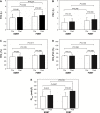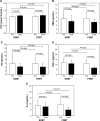Preliminary study: comparative effects of lung volume therapy between slow and fast deep-breathing techniques on pulmonary function, respiratory muscle strength, oxidative stress, cytokines, 6-minute walking distance, and quality of life in persons with COPD
- PMID: 30584292
- PMCID: PMC6287646
- DOI: 10.2147/COPD.S181428
Preliminary study: comparative effects of lung volume therapy between slow and fast deep-breathing techniques on pulmonary function, respiratory muscle strength, oxidative stress, cytokines, 6-minute walking distance, and quality of life in persons with COPD
Abstract
Background: Lung volume therapy with the Voldyne® device can improve lung volume and has a nonsignificant benefit on respiratory muscle strength via the slow deep-breathing technique (SDBT); whereas respiratory muscle training with a respiratory muscle trainer via the fast deep-breathing technique (FDBT) has produced a significant improvement in people with COPD. Thus, the aim of this study was to compare the efficiency of lung volume therapy with the Voldyne® device with the SDBT and FDBT on pulmonary function, respiratory muscle strength, oxidative stress, cytokines, walking capacity, and quality of life (QoL) in people with COPD.
Methods: A total of 30 COPD patient volunteers with mild (stage I) to moderate (stage II) severity were randomized into two groups: SDBT (n=15) and FDBT (n=15). Pulmonary function (FVC, FEV1, and FEV1/FVC), maximal inspiratory mouth pressure (PImax), oxidative stress status (total antioxidant capacity [TAC], glutathione [GSH], malondialdehyde [MDA], and nitric oxide [NO]), inflammatory cytokines (tumor necrosis factor-alpha [TNF-α] and IL-6), 6-minute walking distance (6MWD), and total clinical COPD questionnaire (CCQ) score were evaluated before and after 4 weeks of training.
Results: All the parameters had no statistical difference between the groups before training. The PImax, TAC, IL-6, total QoL score, and 6MWD changed significantly in the SDBT group after the 4-week experiment as compared to those in the pre-experimental period, whereas FVC, FEV1, FEV1%, FEV1/FVC%, PImax, TAC, MDA, NO, TNF-α, IL-6, 6MWD, and total CCQ score changed significantly in the FDBT group as compared to those in the pre-experimental period. The FEV1%, PImax, TNF-α, IL-6, and total CCQ score differed significantly in the FDBT group in the post-experimental period as compared to those in the SDBT group.
Conclusion: This preliminary study concluded that the application of incentive spirometry with the Voldyne® device via fast deep breathing possibly improved respiratory muscle strength and QoL and reduced inflammatory cytokines, MDA, and NO better than that via slow deep breathing among people with COPD.
Keywords: 6-minute walking distance; COPD; cytokines; incentive spirometry; oxidative stress; quality of life.
Conflict of interest statement
Disclosure The authors report no conflicts of interest in this work.
Figures



Similar articles
-
Effects of a simple prototype respiratory muscle trainer on respiratory muscle strength, quality of life and dyspnea, and oxidative stress in COPD patients: a preliminary study.Int J Chron Obstruct Pulmon Dis. 2017 May 12;12:1415-1425. doi: 10.2147/COPD.S131062. eCollection 2017. Int J Chron Obstruct Pulmon Dis. 2017. PMID: 28553094 Free PMC article. Clinical Trial.
-
The relationship between exercise capacity and different functional markers in pulmonary rehabilitation for COPD.Int J Chron Obstruct Pulmon Dis. 2018 Feb 28;13:717-724. doi: 10.2147/COPD.S153525. eCollection 2018. Int J Chron Obstruct Pulmon Dis. 2018. PMID: 29535512 Free PMC article.
-
Reduced Chest and Abdominal Wall Mobility and Their Relationship to Lung Function, Respiratory Muscle Strength, and Exercise Tolerance in Subjects With COPD.Respir Care. 2016 Nov;61(11):1472-1480. doi: 10.4187/respcare.04742. Epub 2016 Oct 18. Respir Care. 2016. PMID: 27794081
-
"Effects of threshold respiratory muscle training on respiratory muscle strength, pulmonary function and exercise endurance after stroke: a meta-analysis".J Stroke Cerebrovasc Dis. 2024 Aug;33(8):107837. doi: 10.1016/j.jstrokecerebrovasdis.2024.107837. Epub 2024 Jun 25. J Stroke Cerebrovasc Dis. 2024. PMID: 38936646
-
Inspiratory muscle training improves respiratory muscle strength, functional capacity and quality of life in patients with chronic kidney disease: a systematic review.J Physiother. 2017 Apr;63(2):76-83. doi: 10.1016/j.jphys.2017.02.016. Epub 2017 Mar 14. J Physiother. 2017. PMID: 28433237
Cited by
-
Effects of Farinelli Breating Exercise on Respiratory Function and Symptoms in Patients with Chronic Obstructive Pulmonary Disease.Tuberc Respir Dis (Seoul). 2022 Apr;85(2):137-146. doi: 10.4046/trd.2021.0109. Epub 2021 Dec 29. Tuberc Respir Dis (Seoul). 2022. PMID: 34965647 Free PMC article.
-
Diaphragmatic strengthening exercises for patients with post COVID-19 condition after mild-to-moderate acute COVID-19 infection: a randomized controlled study.J Rehabil Med. 2024 Jun 11;56:jrm25491. doi: 10.2340/jrm.v56.25491. J Rehabil Med. 2024. PMID: 38860716 Free PMC article. Clinical Trial.
-
Effect of breathing exercises on patients with interstitial lung disease: A systematic review and meta-analysis.Qual Life Res. 2024 Sep;33(9):2335-2347. doi: 10.1007/s11136-024-03679-z. Epub 2024 Jun 22. Qual Life Res. 2024. PMID: 38907831
-
LncRNA Nqo1-AS1 Attenuates Cigarette Smoke-Induced Oxidative Stress by Upregulating its Natural Antisense Transcript Nqo1.Front Pharmacol. 2021 Sep 8;12:729062. doi: 10.3389/fphar.2021.729062. eCollection 2021. Front Pharmacol. 2021. PMID: 34566651 Free PMC article.
-
Mapping the global research landscape and hotspot of exercise therapy and chronic obstructive pulmonary disease: A bibliometric study based on the web of science database from 2011 to 2020.Front Physiol. 2022 Aug 11;13:947637. doi: 10.3389/fphys.2022.947637. eCollection 2022. Front Physiol. 2022. PMID: 36035492 Free PMC article.
References
-
- Cosio MG, Saetta M, Agusti A. Immunologic aspects of chronic obstructive pulmonary disease. N Engl J Med. 2009;360(23):2445–2454. - PubMed
-
- Kirkham PA, Barnes PJ. Oxidative stress in COPD. Chest. 2013;144(1):266–273. - PubMed
-
- Ahmad A, Shameem M, Husain Q. Altered oxidant-antioxidant levels in the disease prognosis of chronic obstructive pulmonary disease. Int J Tuberc Lung Dis. 2013;17(8):1104–1109. - PubMed
-
- Nadeem A, Raj HG, Chhabra SK. Increased oxidative stress and altered levels of antioxidants in chronic obstructive pulmonary disease. Inflammation. 2005;29(1):23–32. - PubMed
Publication types
MeSH terms
Substances
LinkOut - more resources
Full Text Sources
Medical
Research Materials
Miscellaneous

